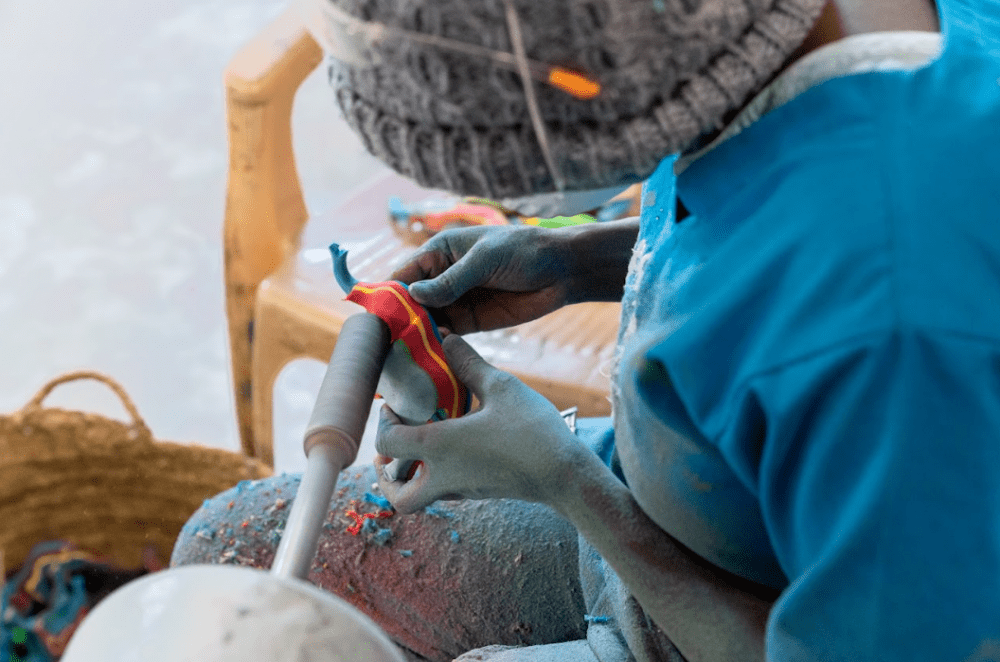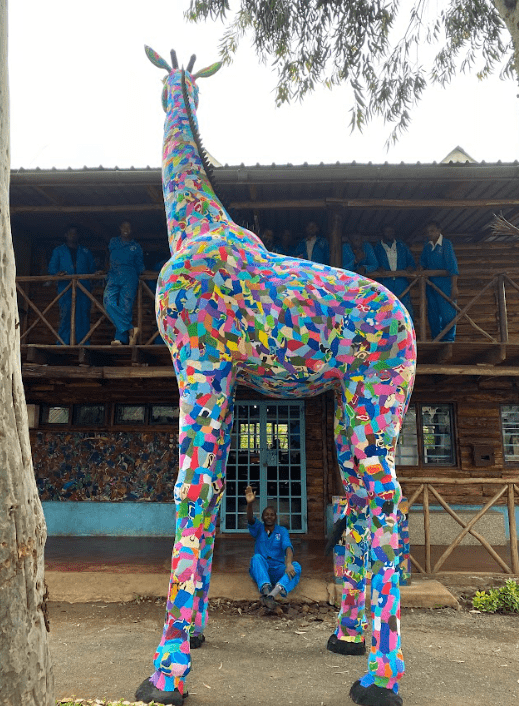Artisans add their final touches to the products made from flip-flops. (Ocean Sole)
When conservationist and marine biologist Julie Church encountered mounds of discarded slip-slops on a beach in Kenya, she was angry. Then she noticed that children were making them into toys, which inspired her to start Ocean Sole, a social enterprise that turns waste into works of art and functional objects.
That was back in 1999. Now the company employs close to 100 people, has recycled just over 695 tonnes of slops since its inception and these creations have travelled the world. We spoke to chief executive Erin Smith to find out more.
What does Ocean Sole do?
We collect discarded flip-flops from landfills, waterways and our weekly beach clean-up on the coast of Kenya. We clean them, disinfect them and create art out of them. Also, we have an education programme in Nairobi and Kilifi where we involve children and adults in fun educational activities about the importance of conserving the environment.
 An Ocean Sole artisan creating a small elephant. (Ocean Sole)
An Ocean Sole artisan creating a small elephant. (Ocean Sole)
How often do you do beach clean-ups and how much trash have you cleared?
We do it every week. We have recycled more than 695.2 tonnes of flip-flops since the social enterprise started in 2006
Explain the process of turning flip-flops into art.
After they are collected, the flip-flops are washed and disinfected, then placed on a rack to dry. For our small, medium and large sculptures, we use a dye-cut machine to get the shape of the animal we intend to make; then, these shapes are glued together to form a block; these blocks of flip-flops are what an artist will carve into a sculpture. After carving, they are sanded to give them that smooth finish; then an artist will put the finishing touches, for example, an ear. The final product gets washed, disinfected and dried. We upcycle styrofoam to make our big sculptures in extra large, double extra large, and masterpiece sizes. We create the body of the animal using styrofoam; then we patch the flip-flops on top using glue, then they get sanded for a smooth finish, and then final touches from the artist. Afterwards, they are washed, disinfected and placed to dry. At this stage, they are ready to be sold.
What challenges has this initiative faced?
With rising costs, shipping our products to our clients internationally has been challenging. The Covid pandemic affected us greatly, and we had to lay off some of our employees; we’re hoping to stabilise and bring them back soon.
 The Ocean Sole giraffe is 5.6m tall. (Ocean Sole)
The Ocean Sole giraffe is 5.6m tall. (Ocean Sole)
Why do you use flip-flops?
Flip-flops are becoming a significant problem, not just for Kenya. They are cheap, therefore affordable to many, and they get dumped once they start to wear away. We clean up the environment by picking up these flip-flops and upcycling them into art. Also, flip-flops are easy to carve. We aim to upcycle a million flip-flops a year. Last year, we upcycled about 572 000.
How can people help or get involved?
You can donate to help support our beach clean-ups or volunteer. You can also purchase our products and help keep our employees employed.
What are some of the most interesting pieces that Ocean Sole has created?
There have been many pieces, but notable ones are:
- A life-sized replica of Big Tim, a 50-year-old long-tusked elephant who died in the Amboseli National Park in 2020. As one of the last tusker elephants in Africa, he was considered a Kenyan national treasure.
- A life-sized model of a Honda S2000. This art piece took almost four months and 3 500 flip-flops to make.
- A life-sized giraffe, which is on display in Portugal.
Where are you located?
We’re at the Karen Village in Karen, Nairobi. We have a fulfilment centre in the United States, at Ponte Vedra Beach.
What vision lies behind the start of the initiative?
To remove trash from the ocean and beaches, save marine wildlife from pollution and to create employment for locals.
If there is just one thing you want people to know about Ocean Sole, what would it be?
We’re passionate about what we do and committed to helping save the environment and marine life.
What’s the initiative’s most significant achievement so far?
We’re proud to have educated 12 000 students on conservation since we started. We believe that children are the future. When we improve knowledge, they can carry on the work when we are not here.
What part of your job ‘sparks joy’?
It is providing jobs and seeing the positive effect of our business.
How do you keep up with news about your sector?
We’re very active on social media and follow many organisations actively doing something to help the environment. We follow organisations like the Oceanic Society, Beach Token and many others.
What is your pet hate?
I wish people would stop using single-use plastics or learn how to recycle them.
How do you hope Ocean Sole will expand?
We can develop and do more when more people purchase our products or offer us donations to support our cause.
This is an edited version of the article first published by Treevolution. Subscribe to their newsletter here.